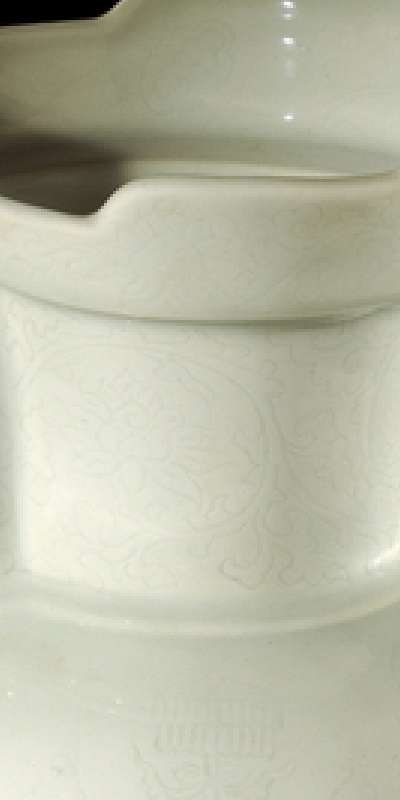
Anhua, a subtle, complicated and not yet fully understood manner of decoration on a Ming, Yongle period (1403-1425), Monk's-cap ewer
Anhua is a specific type of decorative technique used in Chinese porcelain. The name "Anhua" literally means "hidden or secret" referring to the fact that Anhua decoration is thin, near invisible and required to be handled and inspected closely, as the motif is only visible when the object is held up to the light or when light shines through it.
The technique is a subtle, complicated and not yet fully understood manner of decoration that during early Ming involved impressing the design into a layer of slip.One defining feature of its appearance is to be "faint". As for the method, in his Dictionary of Chinese Ceramics, Shanghai 1989, Professor Wang Qingzhen describes Anhua in four various contexts as "faintly incised", and "finely carved or impressed".
On Anhua; "faintly incised", p. 58; On Xuande porcelain "… often covering a vessel with finely carved or impressed designs (Anhua) and decorations", p. 181; On Yongle "tian bai" sweet white ware; "The best type of tian bai ware have faintly incised or impressed designs (Anhua) on them", p. 195; "On Mohammedan blue wares of the Jiajing and Wanli reigns … faintly incised designs (Anhua)", p. 223.
Incised, carved or mould-impressed monochrome decoration under a ceramic glaze was the dominant type of decoration during the Song dynasty, in types of white wares such as Ding ware and Qingbai. But the term Anhua is mainly used of the still more discreet version of the technique popularized under the Yongle Emperor (1360-1424) of the Ming dynasty (1368-1644), whose direct patronage of Buddhism also led to a renewed interest in monochrome white wares.
The Anhua technique was later mastered during the 17th century, becoming a defining feature of Transitional wares, and into the Kangxi (1662-1722) and the Yongzheng (1723-1735) periods, of the Qing dynasty, when dragons sometimes were concealed in the interior of bowls.
Over time Anhua has become a general term covering any type of incised, cut or impressed decoration, applied to any unfired porcelain body ahead of glazing and firing.
On "Kraak porcelain" from the late Ming, impressed ruyi cloud borders is almost a defining feature while having little or nothing to do with classic Anhua decoration.
Export porcelain in blue-and-white, various "families", or as white blanks, came in some cases with carved or incised floral sprays under the glaze, that allowed the glaze to pool in the indentations to create a light-shade effect similar to that of qingbai. This kind of carving design is sometimes described as Anhua but to just incise or impress a pattern onto the unfired porcelain body or rims before it is covered with a clear glaze, is not enough to fit the original definition.
The original meaning as derived from Imperial wares is more limited then that. This said, the common and wider use of the term as 'anything faintly visible under a clear glaze' is probably here to stay.
See also: Incised
A